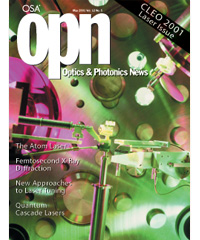
May 2001 Issue
Feature Articles
The Atom Laser
Like the optical laser, the atom laser is based on a quantum principle discovered by Einstein. Both of these devices found their practical realization many years after their underlying concept was articulated in theory, with the optical laser enjoying a lead of about forty years over its atomic sister. As far as mastery of techniques is concerned, the level of advancement of atom laser research today may be viewed as roughly comparable to the state of optical laser research in the early 1960s.
by EdwardW. Hagley, Lu Deng,William D. Phillips, Keith Burnett,and Charles W. ClarkFemtosecond X-Ray Diffraction
By combining traditional x-ray techniques for structural determination with the time resolution of ultrafast laser spectroscopy, researchers are beginning to measure atomic rearrangements directly.
by Andrea Cavalleri, Craig W. Siders, Klaus Sokolowski-Tin - ten,Csaba Tóth,Christian Blome, Jeff A.Squier, Dietrich von der Linde, Christopher P.J.Barty, and Kent R.WilsonNew Approaches to laser tuning
The pace of scientific progress in any area depends greatly on the demands of the market and the available resources. Tunable lasers are a case in point. Though such devices have been the subject of research for over twenty years, only relatively recently have the pull of high bandwidth communications and the importance of optical networks accelerated them to the forefront of research and funding. Any promise of a practical tunable laser can immediately garner the attention of technologists, venture capitalists and large corporations, all of whom realize that these devices are crucial to fulfilling the promises of the information revolution. Nearly a dozen startup companies are com- peting with more established corporations to deliver on a practical tunable laser for optical communications. The technical announcements so far come a long way in satisfying the need, but no panacea that can fully serve the entire market is in sight.
by Bardia PezeshkiFar-Infrared and Ultra-High-Speed Quantum-Cascade Lasers
Surface-plasmon quantum cascade laser. The two metals grating select a single mode by periodically modulating the skin depth.
by Andrea Cavalleri,Craig W. Siders, Klaus Sokolowski-Tin - ten,Csaba Tóth,Christian Blome, Jeff A.Squier, Dietrich von der Linde, Christopher P.J.Barty, and Kent R.WilsonA Packed OFC Breaks Records
OFC 2001, held March 17-22 at the Anaheim Convention Center, was both exhilarating and exhausting. The source of the exhilaration: an opportunity to view an incredible number of amazing achievements across a broad range of fiber-related technologies, from high-speed transmission to exotic new fibers. Exhausting because of the sheer scale of a meeting that roughly doubled in size compared to last year.
by Jeff Hecht
![Illustration of optical skyrmions. [Y. Shen]](https://opnmedia.blob.core.windows.net/$web/opn/media/images/articles/2025/0525/departments/202505-cover-web.jpg?ext=.jpg)
![Illustration of a synapse in the brain. [Getty Images]](https://opnmedia.blob.core.windows.net/$web/opn/media/images/articles/2025/0425/departments/202504-cover-web.jpg?ext=.jpg)
![Fiber draped around a hand, demonstrating its flexibility. [Photo by Z. Wang and L. Wei]](https://opnmedia.blob.core.windows.net/$web/opn/media/images/articles/2025/0325/departments/202503-cover-web.jpg?ext=.jpg)